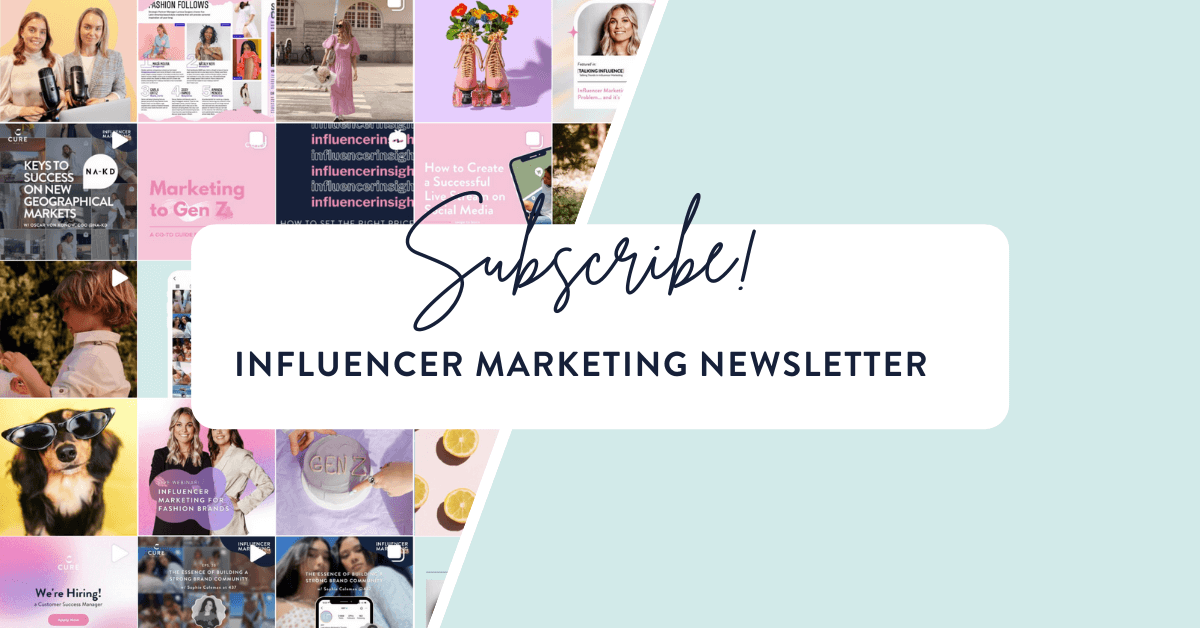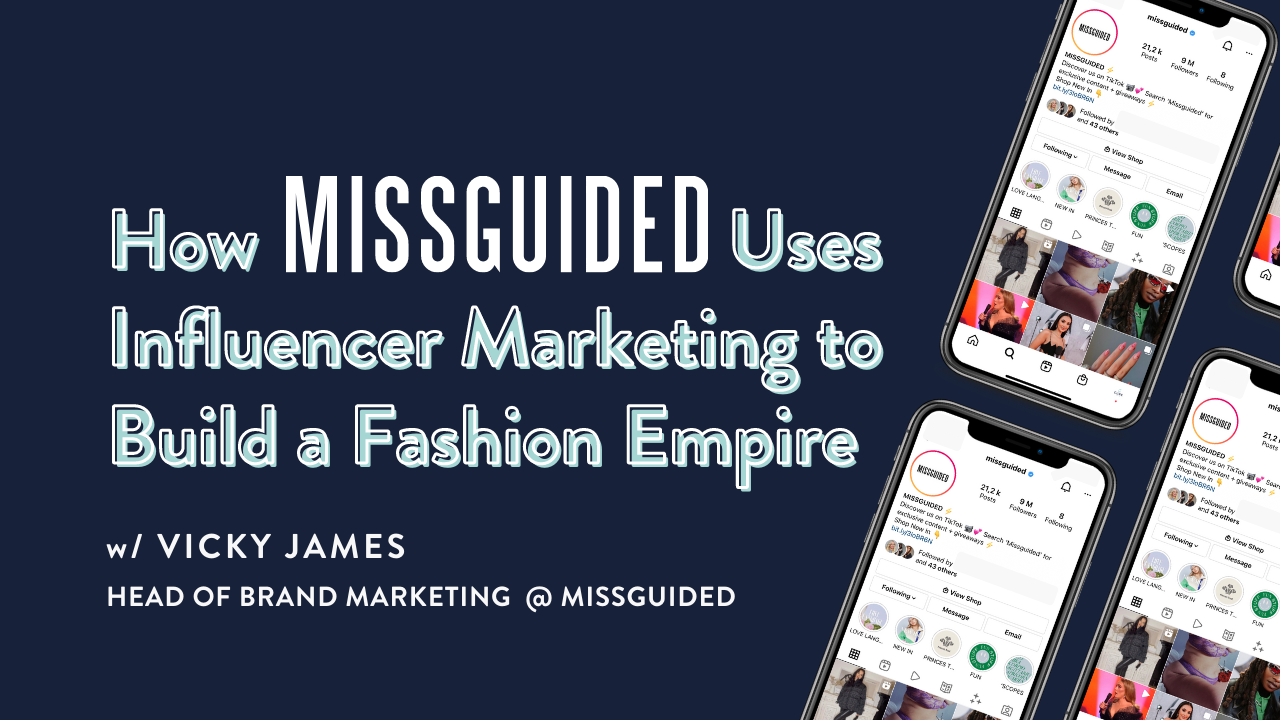In this interview, we are excited to share insights from one of the top players within the social media and influencer marketing landscape: Missguided. Vicky James, Missguided’s Head of Brand Marketing, reflects on how the fashion brand has become one of the UK’s most popular among Millennial and Gen Z shoppers.
Vicky James also discusses her view on brand-building in an evolving marketing landscape, and what it really means to build a brand in today’s world. We finish up with an enlightening discussion about Missguided’s approach to diversity and inclusivity.
This article covers:
- How Missguided attracts Millennials and Gen Z
- The role of influencer marketing at Missguided
- How Missguided measures their branding activities
Prefer to listen? Tune in to this article as a 20-minute podcast episode.
How Missguided stands out in a crowded social media landscape
What is the key to attracting the highly sought-after audiences of Millennials and Gen Z on social media?
I think something we’ve done well, especially in the last couple of years, is shift away from only creating content focused on selling. Ultimately, we are a fashion brand and we sell clothing, and that’s what we need to do. But, it’s really important to have an authentic voice because this audience can see when you’re not being genuine. One thing we definitely try to do across our social channels is to humanise our tone of voice.
At the end of the day, it is our team that posts on our social channels–they’re real people. So, bringing their tone of voice and authenticity across has been key, especially in creating a more engaged community online. People naturally engage more if they see us as a friend rather than a brand, so the team tries to look and think more like the creators themselves.
Consumer behaviour is changing and brands need to do more to stay relevant. Missguided stepped away from traditional media channels in 2019, and today, your highest ad spend is influencer marketing. How do you approach influencer marketing at Missguided?
Our influencer marketing has become a lot more agile and flexible. While we of course still do our more traditional partnerships, such as paid posts or gifting, we have begun to work with creators from a content-first rather than performance-based perspective. We are working more with talents who produce beautiful content and can do things that are out of our scope.
For example, we might have a swim collection…but you don’t want to shoot swim in Manchester. So, it’s great if we have talent based in Los Angeles or Miami that we can send products and a creative brief to. Not just on social media, but actually have them create content that we otherwise would hire a production team for.
Using influencers for a wider range of content has made us more efficient and really helps the team because we don’t have to be out at a photo shoot. It also brings in other people’s point of view, look, and feel. This is the direction we have gone–we have really seen the increased importance of creators–and I think other brands have too.
Watch Vicky and Frida chat about influencer marketing at Missguided in the video below.
Many fashion brands struggle to reach Millennial and Gen Z audiences. What role has influencer marketing and social media played for Missguided in reaching these generations?
It has definitely allowed us to be more agile. Missguided has such a breadth of products for so many different people. If we were to do traditional advertising featuring a few models, then realistically, that might only suit a couple of people’s styles. You’re really pigeon-holed in traditional campaigns. With influencer marketing, we work with hundreds of creators every month and that has allowed us to feature people with different styles and from different communities and backgrounds.
Because each of these creators brings their own point of view, we can reach more people in a more genuine way. At the end of the day, influencers are brand advocates. It’s a word-of-mouth referral similar to asking a friend “omg have you seen this?” or tagging them in a comment on an Instagram post. Consumers really have that trust with influencers.
So, when people see these influencers talk about a brand, especially in the long-term, that’s something we’re very keen on. We don’t want to do one-off partnerships, but rather, a long-term relationship over months and even years. It introduces their community to our community, and in the end, creates a more loyal customer for us.
The Value of Brand Building for Missguided
What most decision-makers don’t know about brand awareness is that it creates sales over time (and also leads to better margins!). I think marketers know that branding is important, but it’s easy to be lured away by the quick wins that a sales-focused activity can bring. How do you work with building brand awareness for Missguided, and what advice would you give to other fashion brands?
A lot of our spend has been focused on social media and influencer marketing, but that’s not to say we’re not doing other things. Missguided is a mature brand in the UK but less so in some of our secondary markets. We definitely want to have a nice mix. In the new markets we enter, influencers are the lowest risk from a cost perspective. Media campaigns or billboards are expensive and risky because they may not work if you’re not well known in the market.
When we want to drive a big spike in awareness for a specific campaign or collection, we lean towards a mass-media approach, whether that’s a billboard or a YouTube campaign. While we don’t do it a lot, when we do, we know it will lead to an uplift in awareness.
Awareness is something we measure monthly. We track awareness, consideration, and purchase intent, and we see those metrics improve over time. It’s really positive I think, building that brand awareness for us at scale. We can’t rely on one channel. We need that omnichannel approach, using traditional media as needed to spread a very wide message.
Something we’re super keen to do this year as the restrictions are lifted is to be in front of our consumers. Even though people spend a lot of time online, they do go outside and are still socialising. We want to meet our consumers where they are, outside of their phones really. Whether that’s pop-ups or guerilla campaigns, we want to be on their mind when they might not be expecting us. That’s something we’re really looking to push this year.
Missguided has shown good turnover the past couple of years, which is said to be due to increased brand awareness. How do you connect the dots between good turnover and increased brand awareness?
We can see how our awareness is tracking over time. Naturally, with higher awareness we expect to see more direct traffic coming through organically, so brand search, or more traffic directly to the app. We especially expect to see those correlations when we are investing heavily in brand marketing or during a big campaign launch.
For us, the key is driving eyeballs, but the right eyeballs, and getting to the right consumer. We are quite performance-driven and try to measure as holistically as possible. For example, if we increase our brand spending, we expect to see an increase in the performance of our Google Ads and paid social ads as well. This is because people are more likely to engage with ads if they have already seen the brand somewhere else.
We really try to find correlations between how our channels impact each other. We even look at how our organic channels impact the paid channels because we want to convert them as high as possible. Overall, the more work we do on the brand side, the more it complements our performance marketing.
Missguided’s take on diversity and inclusivity
Consumers expect more from brands in terms of diversity and inclusion. In response to this, we’ve seen a clear shift in brands’ willingness to take accountability for a lack of diversity and inclusivity in influencer marketing. How does Missguided approach diversity within social media and for your influencer marketing efforts?
I think we are known to have this at the heart of what we do. A few years ago we ran this amazing nudes campaign for our lingerie, which celebrated multiple skin colours and body types. We really want to put women at the forefront who may not traditionally represent fashion brands. It’s important that we have authentic representation in our campaigns so people feel like they don’t have to look like a traditional model to wear Missguided.
In the influencer space, we want to engage with creators that have the same message. For example, we might work with creators that have their own agencies specifically for models of different backgrounds and sizes. Working directly with them and getting their opinion is something we’re very conscious of. We don’t assume what people want to see. When we work with creators who represent a different community, we ask “from your experience as a leader in this area, what do you think will work?”
We have also moved away from being too strict in our creative briefs. Of course, a creator
might need to talk about a certain product, but we don’t say “you need to do this, this, and this.” This allows us to showcase more voices in the content that we create. We need to realise that creators can do a better job than us when it comes to engaging with their community.
Essentially, we always want to utilise creators’ talent and skills and bring that to the brand. This helps us come across as more authentic than if we produced the content ourselves.
Check out our blog or newsletter for more inspiration on how you can approach influencer marketing.



